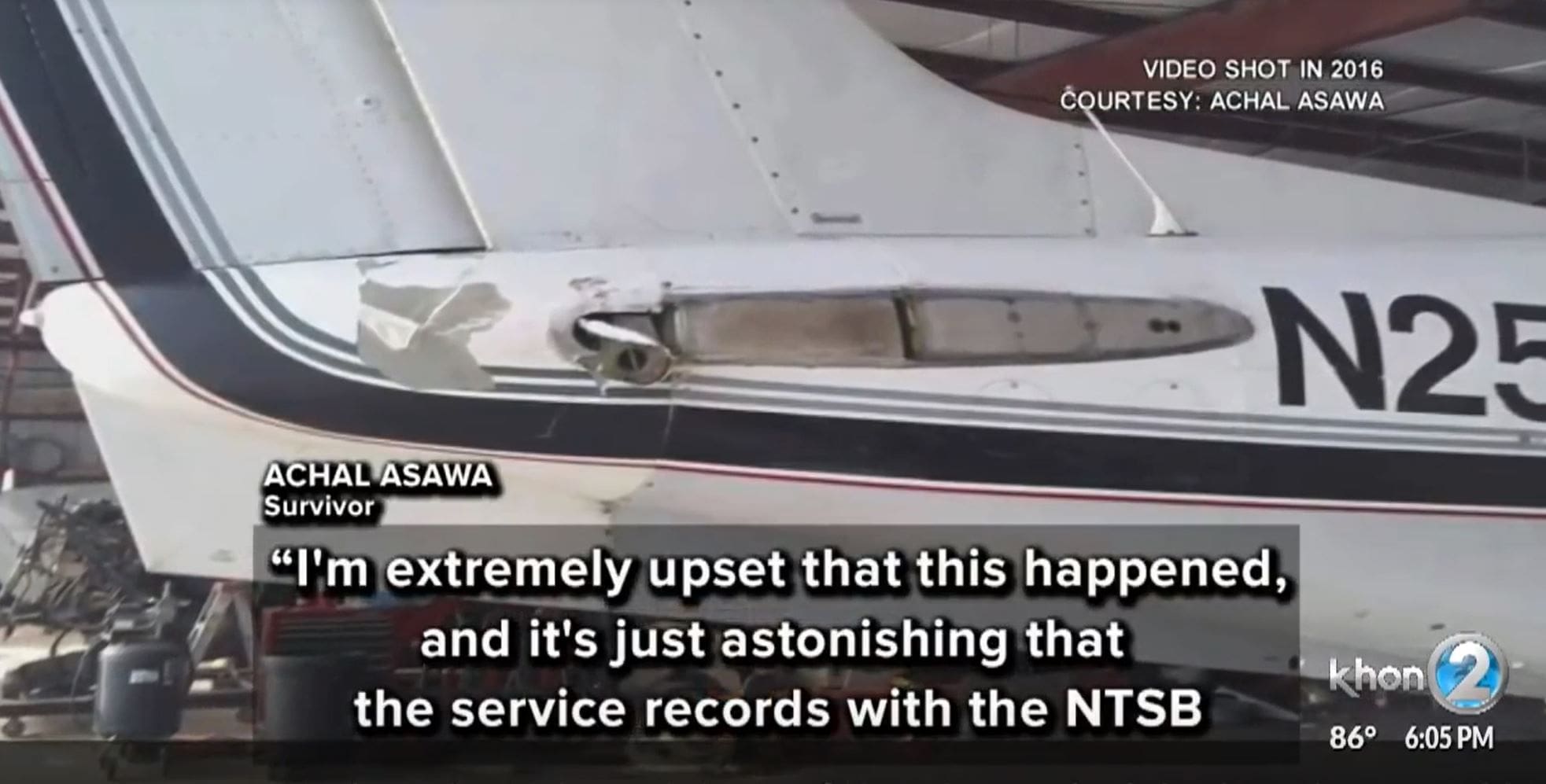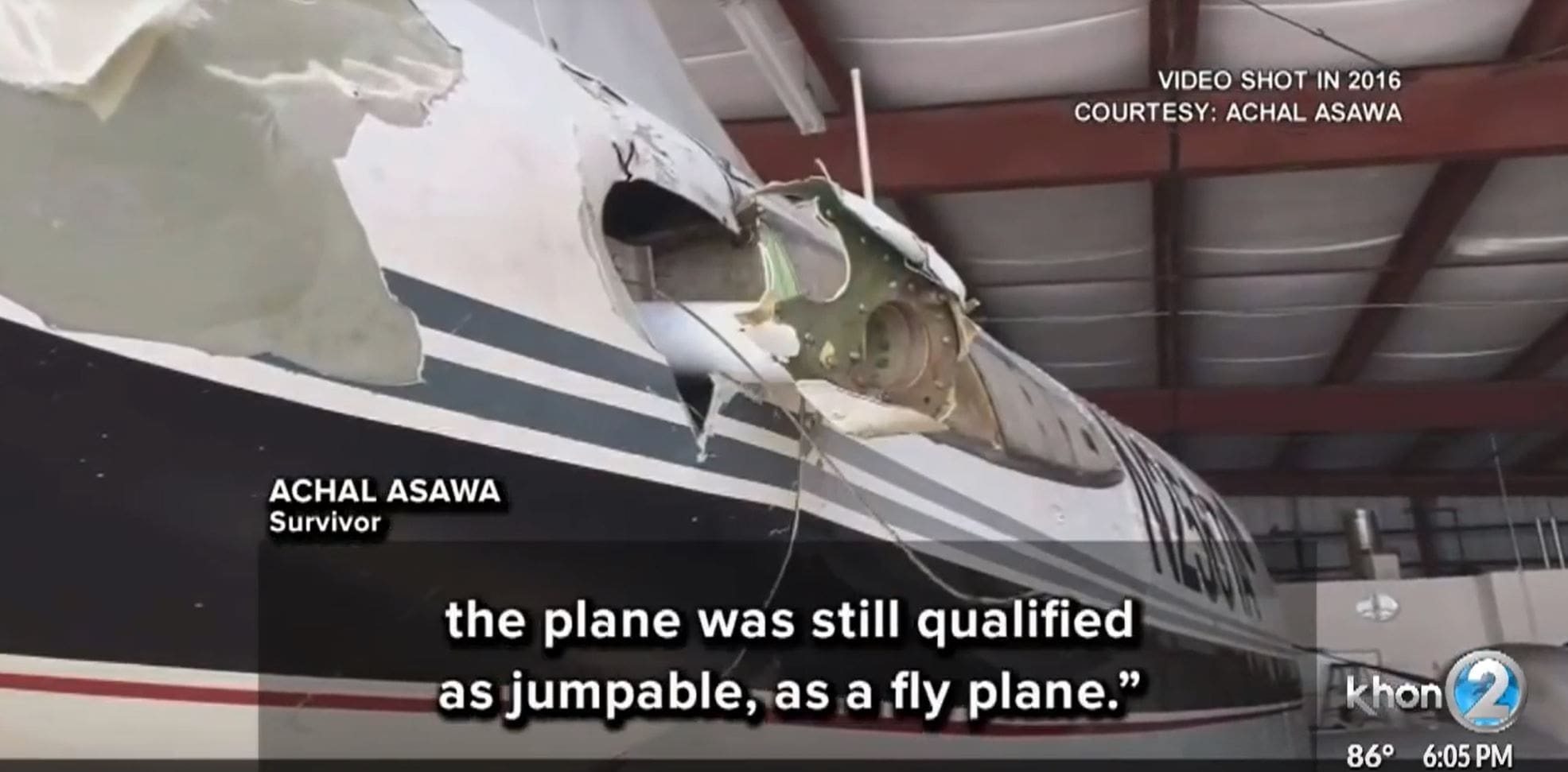King Air down in Oahu
Guest
Join Date: Apr 2009
Location: On the Beach
Posts: 3,336
Likes: 0
Received 0 Likes
on
0 Posts
Join Date: Nov 2015
Location: Paisley, Florida USA
Posts: 289
Likes: 0
Received 0 Likes
on
0 Posts
Here's a video of the spin incident in which the accident airplane lost half of its horizontal stabilizer and its right elevator.
The link:
It looks like everyone aboard during that incident was lucky to get out. I don't think it gets any scarier than that!
Grog
The link:
It looks like everyone aboard during that incident was lucky to get out. I don't think it gets any scarier than that!
Grog
Last edited by capngrog; 25th Jun 2019 at 23:30. Reason: change wording and add sentence
maintenance or loading
Well maybe the jump planes I flew, and their owners, were unusual. If I reported a defect it was fixed. I have declined to fly aircraft that I didn't think were safe but none of them was a jump plane. Overloading of jump planes, particularly aft CG, is likely more of an issue than maintenance. I have told jumpers there were too many in the airplane and if one of them didn't get out then I was going to.
Well maybe the jump planes I flew, and their owners, were unusual. If I reported a defect it was fixed. I have declined to fly aircraft that I didn't think were safe but none of them was a jump plane. Overloading of jump planes, particularly aft CG, is likely more of an issue than maintenance. I have told jumpers there were too many in the airplane and if one of them didn't get out then I was going to.
Unfortunately, when I was 20, and entertained aspirations of flying for a living, I didn’t have the cojones to say that..
Join Date: Nov 2015
Location: Paisley, Florida USA
Posts: 289
Likes: 0
Received 0 Likes
on
0 Posts
In 2015, the FAA issued a Special Airworthiness Information Bulletin (SAIB) concerning the empennage of certain Beech King Air models. The SAIB described inspection procedures for inspection for corrosion. This SAIB may or may not have any bearing on the accident in Hawaii, but it is interesting.
The link to the SAIB:
http://rgl.faa.gov/Regulatory_and_Gu...E/CE-15-15.pdf
Cheers,
Grog
The link to the SAIB:
http://rgl.faa.gov/Regulatory_and_Gu...E/CE-15-15.pdf
Cheers,
Grog
Join Date: Jun 2001
Location: Rockytop, Tennessee, USA
Posts: 5,898
Likes: 0
Received 1 Like
on
1 Post
NTSB Preliminary Report:
https://t.co/FBmzosqXhS
Location: Mokuleia, HI Accident Number: WPR19MA177
Date & Time: 06/21/2019, 1822 HST Registration: N256TA
Aircraft: Beech 65A90 Injuries: 11 Fatal Flight Conducted Under: Part 91: General Aviation - Skydiving
On June 21, 2019, at 1822 Hawaii-Aleutian standard time, a Beech 65-A90, N256TA, collided with terrain after takeoff from Dillingham Airfield (HDH), Mokuleia, Hawaii. The commercial pilot and ten passengers sustained fatal injuries, and the airplane was destroyed. The airplane was owned by N80896 LLC, and was being operated by Oahu Parachute Center (OPC) under the provisions of Title 14 Code of Federal Regulations Part 91 as a local sky-diving flight. Visual meteorological conditions prevailed, and no flight plan had been filed.
According to the owner of OPC, the accident flight was the fourth of five parachute jump flights scheduled for that day. Two flights took place between 0900 and 0930 and the third departed about 1730 on the first of what OPC called, "sunset" flights. The occupants on the accident flight included the pilot, three tandem parachute instructors and their three customers, and two camera operators; two solo jumpers decided to join the accident flight at the last minute.
The passengers were loaded onto the airplane while it was on the taxiway next to the OPC facility on the southeast side of the airport. A parachute instructor at OPC observed the boarding process and watched as the airplane taxied west to the departure end of runway 8. He could hear the engines during the initial ground roll and stated that the sound was normal, consistent with the engines operating at high power. When the airplane came into his view as it headed toward him, it was at an altitude of between 150 and 200 ft above ground level and appeared to be turning. He could see its belly, with the top of the cabin facing the ocean to the north. The airplane then struck the ground in a nose-down attitude, and a fireball erupted.
The final second of the accident sequence was captured in the top left frame of a surveillance video camera located at the southeast corner of the airport. Preliminary review of the video data revealed that just before impact the airplane was in an inverted 45° nose-down attitude.
Runway 8/26 at Dillingham Airfield is a 9,007-ft-long by 75-ft-wide asphalt runway, with displaced thresholds of 1,993 ft and 1,995 ft, respectively. A parachute landing area was located beyond the departure end of runway 8, and the standard takeoff procedure required a left turn over the adjacent beach to avoid that landing zone. The displaced threshold areas had been designated for sailplane and towplane use, with powered aircraft advised to maintain close base leg turns to assure separation.
The airplane came to rest inverted on a heading of about 011° magnetic, 500 ft north of the runway centerline, and 5,550 ft beyond the runway 8 numbers, where the takeoff roll began. The debris field was confined to a 75-ft-wide area just inside the airport perimeter fence. The cabin, tail section, and inboard wings were largely consumed by fire, and both wings outboard of the engine nacelle sustained leading edge crush damage and thermal exposure. Both engines came to rest in the center of the debris field, and fragments of the vertical and both horizontal stabilizers were located within the surrounding area.
Aircraft and Owner/Operator Information Aircraft Make: Beech Registration: N256TA Model/Series: 65A90 Aircraft Category: Airplane Amateur Built: No Operator: Oahu Parachute Center Operating Certificate(s) Held: None
Meteorological Information and Flight Plan Conditions at Accident Site: Visual Conditions Condition of Light: Day Observation Facility, Elevation: PHHI, 840 ft msl Observation Time: 0456 UTC Distance from Accident Site: 10 Nautical Miles Temperature/Dew Point: 24°C / 20°C Lowest Cloud Condition: Few / 5000 ft agl Wind Speed/Gusts, Direction: 4 knots / , 180° Lowest Ceiling: Broken / 7000 ft agl Visibility: 10 Miles Altimeter Setting: 29.94 inches Hg Type of Flight Plan Filed: None Departure Point: Mokuleia, HI (HDH) Destination: Mokuleia, HI (HDH)
Wreckage and Impact Information Crew Injuries: 1 Fatal Aircraft Damage: Destroyed Passenger Injuries: 10 Fatal Aircraft Fire: On-Ground Ground Injuries: N/A Aircraft Explosion: None Total Injuries: 11 Fatal Latitude, Longitude: 21.580556, -158.188333 Administrative Information Investigator In Charge (IIC): Eliott Simpson Additional Participating Persons: Eric West; Federal Aviation Administration AVP-100; Washington, DC Marc Hamilton; Transportation Safety Board of Canada; Ottawa, FN Peter Basile; Textron Aviation; Wichita, KS Note: The NTSB traveled to the scene of this accident.
Date & Time: 06/21/2019, 1822 HST Registration: N256TA
Aircraft: Beech 65A90 Injuries: 11 Fatal Flight Conducted Under: Part 91: General Aviation - Skydiving
On June 21, 2019, at 1822 Hawaii-Aleutian standard time, a Beech 65-A90, N256TA, collided with terrain after takeoff from Dillingham Airfield (HDH), Mokuleia, Hawaii. The commercial pilot and ten passengers sustained fatal injuries, and the airplane was destroyed. The airplane was owned by N80896 LLC, and was being operated by Oahu Parachute Center (OPC) under the provisions of Title 14 Code of Federal Regulations Part 91 as a local sky-diving flight. Visual meteorological conditions prevailed, and no flight plan had been filed.
According to the owner of OPC, the accident flight was the fourth of five parachute jump flights scheduled for that day. Two flights took place between 0900 and 0930 and the third departed about 1730 on the first of what OPC called, "sunset" flights. The occupants on the accident flight included the pilot, three tandem parachute instructors and their three customers, and two camera operators; two solo jumpers decided to join the accident flight at the last minute.
The passengers were loaded onto the airplane while it was on the taxiway next to the OPC facility on the southeast side of the airport. A parachute instructor at OPC observed the boarding process and watched as the airplane taxied west to the departure end of runway 8. He could hear the engines during the initial ground roll and stated that the sound was normal, consistent with the engines operating at high power. When the airplane came into his view as it headed toward him, it was at an altitude of between 150 and 200 ft above ground level and appeared to be turning. He could see its belly, with the top of the cabin facing the ocean to the north. The airplane then struck the ground in a nose-down attitude, and a fireball erupted.
The final second of the accident sequence was captured in the top left frame of a surveillance video camera located at the southeast corner of the airport. Preliminary review of the video data revealed that just before impact the airplane was in an inverted 45° nose-down attitude.
Runway 8/26 at Dillingham Airfield is a 9,007-ft-long by 75-ft-wide asphalt runway, with displaced thresholds of 1,993 ft and 1,995 ft, respectively. A parachute landing area was located beyond the departure end of runway 8, and the standard takeoff procedure required a left turn over the adjacent beach to avoid that landing zone. The displaced threshold areas had been designated for sailplane and towplane use, with powered aircraft advised to maintain close base leg turns to assure separation.
The airplane came to rest inverted on a heading of about 011° magnetic, 500 ft north of the runway centerline, and 5,550 ft beyond the runway 8 numbers, where the takeoff roll began. The debris field was confined to a 75-ft-wide area just inside the airport perimeter fence. The cabin, tail section, and inboard wings were largely consumed by fire, and both wings outboard of the engine nacelle sustained leading edge crush damage and thermal exposure. Both engines came to rest in the center of the debris field, and fragments of the vertical and both horizontal stabilizers were located within the surrounding area.
Aircraft and Owner/Operator Information Aircraft Make: Beech Registration: N256TA Model/Series: 65A90 Aircraft Category: Airplane Amateur Built: No Operator: Oahu Parachute Center Operating Certificate(s) Held: None
Meteorological Information and Flight Plan Conditions at Accident Site: Visual Conditions Condition of Light: Day Observation Facility, Elevation: PHHI, 840 ft msl Observation Time: 0456 UTC Distance from Accident Site: 10 Nautical Miles Temperature/Dew Point: 24°C / 20°C Lowest Cloud Condition: Few / 5000 ft agl Wind Speed/Gusts, Direction: 4 knots / , 180° Lowest Ceiling: Broken / 7000 ft agl Visibility: 10 Miles Altimeter Setting: 29.94 inches Hg Type of Flight Plan Filed: None Departure Point: Mokuleia, HI (HDH) Destination: Mokuleia, HI (HDH)
Wreckage and Impact Information Crew Injuries: 1 Fatal Aircraft Damage: Destroyed Passenger Injuries: 10 Fatal Aircraft Fire: On-Ground Ground Injuries: N/A Aircraft Explosion: None Total Injuries: 11 Fatal Latitude, Longitude: 21.580556, -158.188333 Administrative Information Investigator In Charge (IIC): Eliott Simpson Additional Participating Persons: Eric West; Federal Aviation Administration AVP-100; Washington, DC Marc Hamilton; Transportation Safety Board of Canada; Ottawa, FN Peter Basile; Textron Aviation; Wichita, KS Note: The NTSB traveled to the scene of this accident.
https://t.co/FBmzosqXhS
Join Date: Jun 2001
Location: Surrounded by aluminum, and the great outdoors
Posts: 3,780
Likes: 0
Received 0 Likes
on
0 Posts
I continue to run a couple of aviation businesses 35 years down the road from my time as a jump pilot.
Tell me how to run my career when you get here laddybuck...
Last edited by 421dog; 11th Jul 2019 at 02:02.






